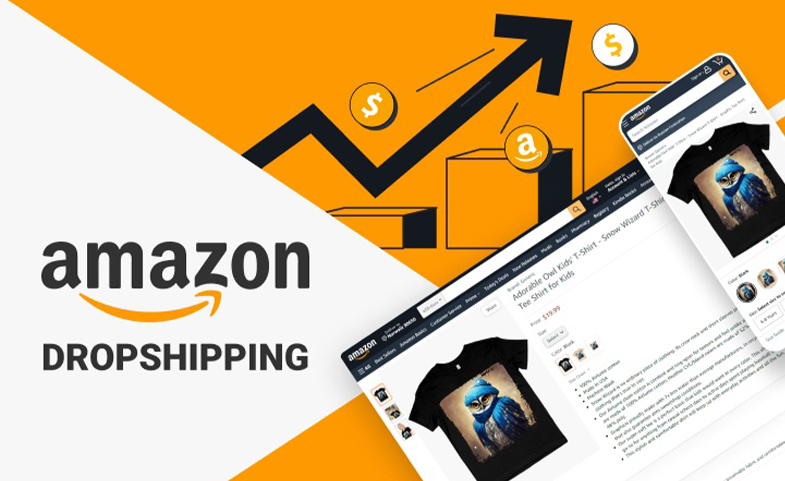What is dropshipping?
Dropshipping is an order fulfillment option that allows ecommerce businesses to outsource the processes of procuring, storing, and shipping products to a third party—typically a supplier.This fulfillment model commonly appeals to entrepreneurs seeking efficiency and low overhead, but it can come at a cost—especially when it comes to customer experience.
How does dropshipping work on Amazon?

Dropshipping on Amazon operates through a straightforward yet intricate process involving three key players: the seller, the supplier, and the customer. The seller, typically an entrepreneur or business, collaborates with a third-party supplier, such as a manufacturer, wholesaler, or retailer. Here's a breakdown of how the dropshipping model unfolds on Amazon:
Amazon Seller Account Creation:
- To kickstart the dropshipping journey on Amazon, the seller first establishes an account through Amazon Seller Central.
Customer Orders on the Marketplace:
- Customers browsing the Amazon store of the seller discover products they wish to purchase. They place an order and complete the payment transaction.
Placing Orders with the Supplier:
- Upon receiving the customer's order and payment, the seller communicates with their chosen supplier to place an order for the selected product. The seller covers the product's cost and provides the customer's shipping details.
Direct Shipping from Supplier to Customer:
- The supplier, often a manufacturer or wholesaler, takes charge of packaging and directly shipping the ordered product to the customer. The supplier furnishes the seller with tracking information for order monitoring.
Customer Service and Returns Management:
- Despite not physically handling the products, the seller assumes responsibility for customer service inquiries and managing returns. Customers reach out to the seller through Amazon's messaging system for any queries or concerns.
Profit Generation:
- The seller determines the selling price for the product on Amazon, typically setting it higher than the cost paid to the supplier. The profit is the margin between the selling price and the supplier's cost. It's crucial to maintain consistent pricing across all selling platforms to prevent discrepancies.
In the dropshipping model, the seller concentrates on customer relations, marketing, and sales, while the supplier manages logistics aspects like warehousing, packing, and shipping. This collaborative effort ensures efficient product delivery to customers.
Is Dropshipping the Right Fit for You? Consider These Factors:
Building Your Brand:
- Before starting dropshipping, be aware that it has limitations for branding. You have less control over product quality and delivery appearance.
- However, you can still build a brand by creating a nice website, working with your supplier for quality, and ensuring reliable delivery for a memorable customer experience.
Product Quality Assurance:
- As a dropshipper, it's tricky to control product quality because it's in the hands of the supplier. Bad products can get you bad reviews and harm your reputation. To avoid this, pick reliable suppliers by researching, checking reviews, and asking for product samples.
- Even with quality challenges, great customer service can build a strong reputation and keep customers coming back.
Swift Product Delivery:
- Fast and reliable shipping is essential in e-commerce. Ensure your dropshipping supplier offers quick shipping options, and consider using services like Fulfillment by Amazon (FBA) for efficient order fulfillment.
- FBA allows you to store products in Amazon's warehouses, enabling faster shipping and potentially improving your search rankings. Prioritize fast shipping to enhance the customer experience and satisfaction.
Targeting Profit Margins:
- Making big profits in dropshipping is tough because of lots of competition. Usually, profits are 5-20%. To stand out, find niches with better profits through research, connect with suppliers, and check sales data.
- Stand out by giving great customer service, handling returns well, and creating a strong brand. This builds loyalty, a good reputation, and lets you charge higher prices for better profits.
Potential Advantages of Dropshipping:
Overhead Cost Reduction:
- With no need to manage storage facilities or handle shipping logistics, dropshipping can significantly lower overhead costs for businesses.
Low Starting Costs:
- Entrepreneurs with limited capital can benefit from dropshipping, as it eliminates the need for substantial upfront investments in facilities or order processing resources.
Reduced Risk:
- Since there's no upfront payment for inventory, the risk of financial loss due to lost merchandise or over-ordering is minimized.
Multi-Channel Selling:
- Dropshipping enables businesses to sell products across various channels, including their website, Amazon, or social media platforms, providing flexibility and broad market reach.
Operating Location Independence:
- Dropshipping allows for order fulfillment from anywhere, providing the flexibility to operate the business from different locations.
Scalability:
- Leveraging suppliers enables businesses to handle increased order volumes without the need to expand inventory storage and shipping capabilities.
Wide Product Variety:
- Without the requirement to pre-purchase inventory, businesses can offer a diverse range of products, expanding their potential for revenue generation.
Flexibility for Product Testing:
- Dropshipping allows businesses to experiment with different products to identify what resonates with customers, without the fear of losing a substantial investment.
Potential Drawbacks of Dropshipping:
Intense Competition:
- The low entry barriers result in a highly competitive dropshipping landscape, making it challenging to stand out.
Product Quality Control:
- Limited involvement in the fulfillment process hampers the ability to monitor and guarantee the quality of products sold.
Branding Challenges:
- Selling products that aren't distinct may make it difficult to differentiate your brand from competitors, impacting brand identity.
Margin Pressures:
- The lack of product differentiators may lead to aggressive price competition, potentially squeezing profit margins.
Fulfillment Limitations:
- Dropshippers relinquish control over the fulfillment process, including order selection, packaging, and shipment.
Inventory Management Issues:
- Real-time updates on available stock may be unavailable, risking customer dissatisfaction if products are out of stock after an order is placed.
Limited Special Offers:
- Dropshippers may have constraints in running promotions like bundling or free shipping due to the absence of direct control over order fulfillment.
Supplier Errors:
- Low-quality dropshipping partners may make errors in order fulfillment, leading to issues like incorrect orders, subpar packaging, and missing items.
Complex Customer Service:
- Despite outsourcing fulfillment, businesses are still accountable for customer satisfaction. Managing customer support becomes challenging if issues arise in the fulfillment process.
How to build a dropshipping business in 2024
1. Choose a Niche:
- Start by selecting a niche for your dropshipping business. Specializing in a specific area allows you to build a brand and target a defined audience, setting you apart from competitors.
2. Conduct Competitor Research:
- Before finalizing your niche, conduct thorough competitor research. Assess the level of competition and market saturation.
- If a niche appears oversaturated or dominated by large brands, consider exploring alternative niches to maximize your chances of success.
3. Find a Quality Dropshipper:
- Partner with a reputable dropshipper known for accurate, on-time deliveries and high-quality products.
- Consider going directly to manufacturers to reduce middlemen involvement and assess a dropshipper's reputation through customer reviews and contact information on their website.
4. Create an Online Store:
- Establish an ecommerce storefront to showcase your brand and products. This serves as a centralized destination for potential customers to learn about your business.
5. Encourage Sales with Marketing:
- Utilize a mix of paid ads on search engines and social media to drive traffic to your online store. Leverage advertising options if you're selling on platforms like Amazon to enhance visibility in search results.
6. Analyze and Optimize Listings:
- Leverage tools like Amazon's brand analytics dashboard to monitor store metrics. Analyze sales trends, understand customer preferences, and optimize listings to improve search result rankings. Continuously update your catalog with high-demand products.
Selecting the Right Dropshipper:
- Direct sourcing from manufacturers.
- Checking the dropshipper's website for reputation indicators.
- Reading customer reviews for insights into the supplier's performance.
- Requesting product samples to assess shipping speed and quality.
- Testing customer support responsiveness and issue resolution.
Questions to Ask a Dropshipping Supplier:
Inquire about policies, including handling returns, order fulfillment speed, insurance, fraud protection, tracking numbers, billing process, terms in the dropshipping agreement, and associated fees..
Conclusion:
In conclusion, Amazon dropshipping is a dynamic and accessible way for entrepreneurs to enter the e-commerce landscape. By understanding the fundamentals, following best practices, and staying adaptable, sellers can navigate the complexities of the Amazon marketplace and build a thriving dropshipping business.Mastering the art of Amazon dropshipping serves as a roadmap for achieving sustainable success in the ever-evolving world of online retail.


